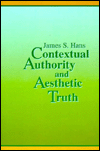

 |

|

The average rating for Contextual authority and aesthetic truth based on 2 reviews is 4.5 stars.
Review # 1 was written on 2015-02-04 00:00:00 Tori Smith Tori SmithWhat saves this book is superlative phrase-turning and humor, intended or otherwise. If you've ever been tempted to bronze your subjective aesthetic and mount it in the museum between philosophy and science, this will be there to remind you how nearly impossible it is to pull off. Kandinsky couldn't do it and neither can you. I mean he sets forth to launch a theory of color analogized to harmonics, but what really comes through is an abiding disdain for yellow, coupled with a love letter to blue. His statement of artistic intent- you gotta pat him on the back for that idealistic "whoosh"- appears equally specious. It's not that he's lying. It's just that his sleight of hand skills are pretty amateur so the part where he goes "oh so my plan includes this, this, and that, from this day forward" comes across pretty nakedly as a review of past and current work. It reminds me of having to write artist statements. These are a bitch, which is my thoroughly unscientific perspective. They are a bitch because they are more often than not worded as a request for a statement of artistic intent. Last I checked, "I'm going to pick up this brush and paint until I get lost, and paint some more until I come out the other side. Motherfucker." rarely cuts it. Because that doesn't really translate into anything but maximum snark - it's sort of like getting spattered with paint for asking "what are you doing?" The thing is, that statement is absolutely honest, it just doesn't make sense in any language outside the living craft of painting, and so to write a statement, I have to open the door to that compact structure of dream logic, walk outside, and look in the window and describe what I see. This, however, is not the same thing as writing a grocery list, even if it's written on paper covered with vegetables, as a bullet-list. All I can do is write what I see. I can't predict where process will take me, the most I can do is make preparatory drawings as points of departure. Maybe Kandinsky was a precog. His enthusiasm for the path away from representation, for the synthesis of the arts, for advances of the spirit through science likely conflated observable trends in his existing body of work with future intent. And it's not just a little heart-breaking (but funny, always funny) to encounter his One True Quest towards pure expression conveyed upon such muddy waters. |
Review # 2 was written on 2017-11-30 00:00:00 Jose Flores Jose FloresTheory is the lamp which sheds light on the petrified ideas of yesterday and of the more distant past. The first time I saw a painting by Kandinsky was in the Guggenheim Museum. Back then, I really didn't have much appreciation for visual art, least of all abstract paintings. Nevertheless, I remember being intrigued, and finally fascinated by his work. The way he was able to select forms reminiscent of, but not dependent on, real-life objects delighted my eye. Later, I saw a special exhibition of Kandinsky's work in Madrid. It was divided by place and time, taking me through his Russian, German, and Parisian period, during which he moved from representative art to complete abstraction. I came away from that exhibit with my interest in Kandinsky re-confirmed, and now I can say that he is one of my favorite 20th century artists. Concerning the Spiritual in Art is a short book (more like an extended essay) by Kandinsky, detailing his personal philosophy of art. For Kandinsky, the artist is like a prophet, able to see farther, think more deeply, and feel more keenly than ordinary people. The great artist's function is to satisfy the cravings of the spirit. In music this is done through rhythm and melody; in painting through color and form. The spiritual function of art has been hampered by what Kandinsky calls materialism'representative art. The accurate reproduction of an object's appearance is pointless in itself; what matters is its truth to the inner, not the outer, reality. Then follows a long chapter on Kandinsky's theory of colors'which colors evoke which emotions, and their relationship to one another. As a work of theory, Kandinsky's book is somewhat disappointing. It is more of a manifesto than a treatise'a simple declaration of Kandinsky's opinions. As such, it is more interesting as a look into the mind of a great artist than as a piece of art theory. Kandinsky's discussion of colors and shapes, for example, is silly as analysis, but fascinating as a peek into Kandinsky's brain. Triangles, circles, squares; reds, yellows, blues'all these were like characters for Kandinsky, with their own personalities and temperaments. It was a pleasure to get to know him better. |
CAN'T FIND WHAT YOU'RE LOOKING FOR? CLICK HERE!!!